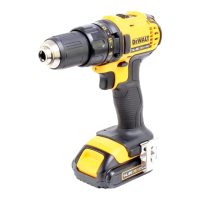English
7
• Thesechargersarenotintendedfor
any uses other than charging D
eWALT
rechargeable batteries. Any other uses
may result in risk of fire, electric shock or
electrocution.
• Donotexposechargertorainorsnow.
• Pullbyplugratherthancordwhen
disconnecting charger. This will reduce risk
of damage to electric plug and cord.
• Makesurethatcordislocatedsothatitwill
not be stepped on, tripped over or otherwise
subjected to damage or stress.
• Donotuseanextensioncordunlessit
is absolutely necessary. Use of improper
extension cord could result in risk of fire,
electric shock or electrocution.
• Whenoperatingachargeroutdoors,always
provide a dry location and use an extension
cord suitable for outdoor use. Use of a cord
suitable for outdoor use reduces the risk of
electric shock.
• Donotblocktheventilationslotsonthe
charger.Theventilationslotsarelocated
on the top and sides of the charger. Place
the charger in a position away from any heat
source.
• Donotoperatechargerwithdamagedcord
or plug — have them replaced immediately.
• Do not operate charger if it has received
a sharp blow, been dropped or otherwise
damaged in any way. Take it to an authorised
service centre.
• Donotdisassemblethecharger;takeitto
an authorised service centre when service or
repair is required. Incorrect reassembly may
result in a risk of electric shock, electrocution or
fire.
• Incaseofdamagedpowersupplycordthe
supply cord must be replaced immediately by
the manufacturer, its service agent or similar
qualified person to prevent any hazard.
• Disconnect
thechargerfromtheoutlet
beforeattemptinganycleaning.Thiswill
reduce the risk of electric shock. Removing
the battery pack will not reduce this risk.
• NEVERattempt to connect 2 chargers together.
• Thechargerisdesignedtooperateon
standard220~240Vhouseholdelectrical
power. Do not attempt to use it on any other
voltage. This does not apply to the vehicular
charger.
Save tHeSe inStructionS
Chargers
Charging
The DCB105 and DCB115 charger accepts 10.8
V,
14.4V and 18V Li-Ion (DCB121, DCB140, DCB141,
DCB180, DCB181, DCB182 , DCB1 83 and
DCB184) battery packs.
This charger requires no adjustment and is designed
to be as easy as possible to operate.
P
rocedure (figure 2)
1. Plug the charger into an appropriate 220~240 V
outlet before inserting the battery pack.
2. Insert the battery pack (j) into the charger,
making sure the pack is fully seated in the
charger. The red (charging) light will blink
continuously indicating that the charging
process has started.
3. The completion of charge will be indicated by
the red light remaining ON continuously. The
pack is fully charged and may be used at this
time or left in the charger.
NOTE: To ensure maximum performance and life of
Li-Ion batteries, charge the battery pack fully before
first use.
Charging Process
Refer to the table below for the state of charge of
the battery pack.
Charge indicators: DCB10
5
charging –– –– –– ––
fully charged –––––––––––––––––
hot/cold pack delay –– • –– • –– • –– •
x
problem pack or charger • • • • • • • • • • • •
problem powerline •• •• •• •• •• ••
Charge indicators: DCB115
charging
fully charged
hot/cold pack delay*
This charger will not charge a faulty battery pack.
The charger will indicate faulty battery by refusing to
light or by displaying problem pack or charger blink
pattern.
NOTE: This could also mean a problem with a
charger.

